8+ Sample Joint Discovery Plan
-

Joint Discovery Plan Template
download now -
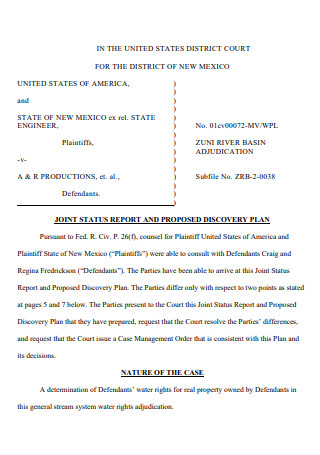
Joint Status Report and Proposed Discovery Plan
download now -
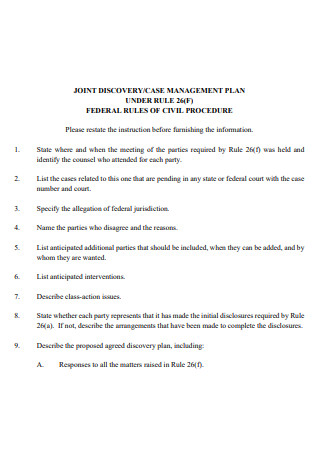
Joint Discovery Management Plan
download now -
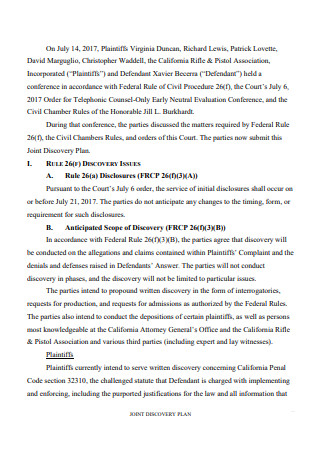
Joint Discovery Plan Example
download now -
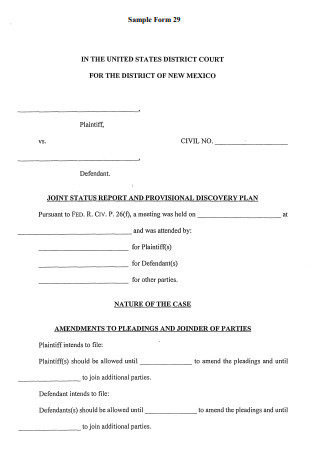
Joint Status Report and Provisional Discovery Plan
download now -
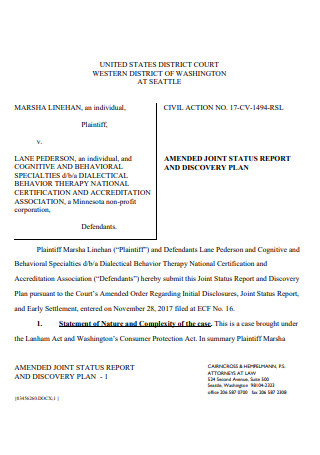
Amended Joint Status Report and Discovery Plan
download now -
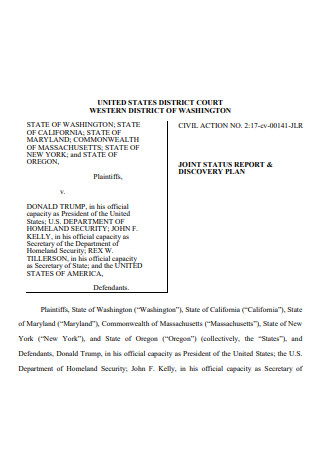
Joint Status Report and Discovery Plan
download now -
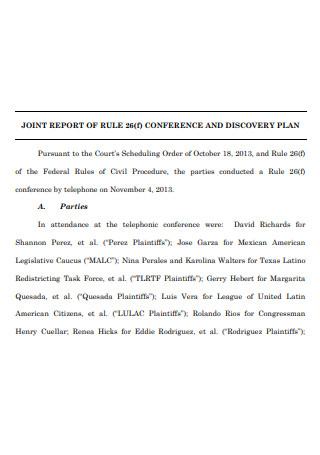
Joint Report of Conference and Discovery Plan
download now -
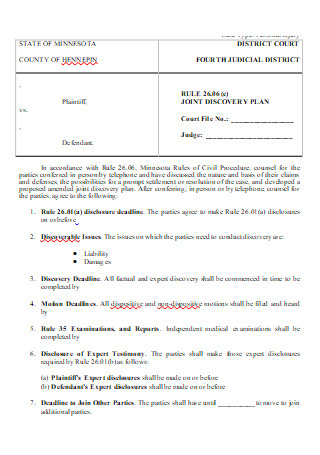
Joint Discovery Plan in DOC
download now
FREE Joint Discovery Plan s to Download
8+ Sample Joint Discovery Plan
What is a Joint Discovery Plan?
Types of Discovery
How to Develop a Joint Discovery Plan
FAQs
What is a Joint Rule 26 F report?
What are the basic discovery tools?
What are the types of discovery methods in family court?
What are some common examples of discovery materials?
What is the discovery and inspection process in a civil procedure?
What is a Joint Discovery Plan?
A joint discovery plan is a comprehensive and formal technique and case management plan for setting up common discovery arrangements for pending related cases in federal courts. It is prepared when the plaintiffs and defendants held a conference in accordance with the Federal Rule of Civil Procedure 26(f). The conference is held to let the parties discuss the matters required by Federal Rule 26 (f), the Civil Chambers Rules, and the Court orders. Discovery in a civil case is a prerequisite step in a lawsuit in which each party investigates the facts of a case based on the civil procedure rules.
This case management plan and documentation plan is composed of these sections: Rule 26(f) Disclosures, anticipated scope of discovery, electronically stored information, privilege issues, changes to discovery limitations, other discovery and scheduling orders, witnesses the parties intend to depose, documents requested for production, discovery to enable settlement evaluation, issues implicating expert evidence, threshold legal issues for the motion for summary judgment, the procedure for claims of privilege, anticipated protective orders, and proposed schedule.
Types of Discovery
When the plaintiff files a complaint against the defendant, it initiated a civil lawsuit and then enters a stage known as the discovery process. The discovery process is the pre-trial stage in a lawsuit during a thorough investigation of each party on the facts of a case through the rules of civil procedure. They obtained evidence from the opposing party and others while using discovery tools.
How to Develop a Joint Discovery Plan
A discovery process brings to light some important details that would guide either party to delve through their respective strengths and weaknesses and their chances of litigating the case. Consider the following steps so that you can easily develop your joint discovery plan.
Step 1: Work on the Preliminary Matters
Before you draft a complaint or responsive pleading, specify the major areas in which evidentiary support for assertions in those documents will be required. Create a chart that contains the certain elements of each claim or defense asserted and determining possible evidence for individual element. Review the local rules of the court meticulously as you consult the judge’s standing order, mainly related on discovery matters, as well as all discovery rules specific to jurisdiction as you focus on the requirements of mandatory initial disclosures and rules governing the discoverability of specific categories of materials that might use to the case.
Step 2: Schedule a Meeting or Conference Call
Set up a meeting or conference call to enable discussion about the discovery procedure with the opposing counsel. Although in jurisdictions where a joint discovery plan is not mandatory, this meeting or conference gives an opportunity to build a pattern of cooperation in the discovery process. If attempts to meet or confer are rejected, the attorney who proposed the meeting will have made documentation of attempting to be reasonable in the discovery procedure because it may influence the later rulings of the presiding judge on the contentious discovery process.
Step 3: File a Comprehensive Joint Discovery Plan
If mandatory or permitted, file a joint discovery plan with the court before the initial pre-trial. Make some suggestions on the right number of interrogatories, requests for production of documents, and depositions for the case and reasonable deadlines for the conclusion of all discovery matters.
Step 4: Provide Sufficient Information
Provide enough information about the client’s past and current employees who have information related to the claims and defenses of the client. Include the contact details or the most latest contact details available from the personnel files. Comply with the mandatory disclose of documents and data compilations.
Step 5: Describe the Discovery Plan
Include these information while describing your discovery plan: responses to all the matters raised in Rule 26(f) which includes agreements relevant to electronic discovery, when and to whom the plaintiff and the defendant expects it may send interrogatories, of whom and by when the plaintiff and the defendant anticipated taking oral depositions, when the plaintiff and the defendant can assign experts and provide Rule 26(s)(2)(b) reports, and list expert depositions the plaintiff and the opposing party anticipates taking and their anticipated completion date.
FAQs
Required by the Federal Rule of Civil Procedure (FRCP), a Joint Rule 26 F report is a sample report and discovery plan used by parties to memorialize the results of their meetings and conferences. This document contains drafting notes with detailed essential explanations and drafting tips.
The common discovery tools used by many civil legal professionals are depositions, interrogatories, requests for admissions, requests for the production of documents, requests for inspection, and e-discovery.
The types of discovery methods in family court are interrogatories, requests for the production of documents and inspection like an inspection report, requests for admissions, depositions, subpoenas duces tecum, physical examinations, and mental health examinations.
Some common examples of discovery materials are affidavit documents, depositions, file notes, deposition transcripts, important business documents, interview reports, interview transcripts, declarations, and videos.
The discovery and inspection process in a civil procedure takes place when the plaintiff or defendant is able to get information about the material facts of each other or documents possessed by the other parties or power associated to the issue in the case.
When you prepare a joint discovery plan, make sure that you comply with the court rules in your area and follow the instructions in developing this case management plan such as stating where and when the parties held the meeting or conference required by Rule 26(f), describing what the case is all about, indicating the basis of federal jurisdiction, listing any expected additional parties and any anticipated interventions, and describing the proposed agreed joint discovery plan. To fully guide you in the development of your joint discovery plans or case management plans, Sample.net offers a diverse collection of well-designed PDF document templates for legal cases such as a What is a Joint Rule 26 F report?
What are the basic discovery tools?
What are the types of discovery methods in family court?
What are some common examples of discovery materials?
What is the discovery and inspection process in a civil procedure?
